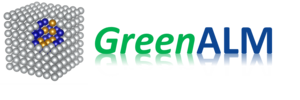GreenALM
GreenALM (Green’s functions based Alloy Modeling) is a software toolkit based on density functional theory using a Green’s functions approach. It is especially efficient and versatile for the calculation of chemically and magnetically complex alloys, including random multicomponent alloys and paramagnetic systems. Moreover, GreenALM provides a workflow for doing alloy thermodynamics.
Special features implemented and under development:
-
Coherent Potential Approximation (CPA) for random alloys: The CPA [Soven1967, Gyorffy1972, Ruban2008] efficiently treats multi-component alloys on a mean-field basis, which facilitates the treatment of substitutional multicomponent alloy on a simple personal computer.
-
Disordered Local Moments (DLM) method for paramagnetism: The DLM method [Cyrot1970, Gyorffy1972] is a way to calculate true paramagnetic systems, i.e. systems with non-vanishing local magnetic moments averaging out macroscopically.
-
Treatment of Longitudinal Spin Fluctuations for systems with itinerant magnetism [Ruban2007]
-
Locally self-consistent Green’s function (LSGF) formalism for atomic short-range order and extended defects: The LSGF formalism [Abrikosov1997, Peil2012] is a generalization of the CPA able to deal with extended defects and atomic short-range order in solid solutions. In this formalism, a (large) supercell is treated using the concept of local interaction zones of real atoms embedded in an effective medium. It is computationally very efficient for large supercells, since the computation time scales linearly with the number of atoms, and thus allows treating much larger cells compared to conventional DFT methods.
-
Screened Generalized Perturbation Method (SGPM) for direct calculation of Effective Cluster Interactions in alloys: The SGPM [Ruban2002, Ruban2002a, Ruban2004, Ruban2008] methods allows direct calculation of Effective Cluster Interactions (ECIs) from Green’s functions based electronic structure calulations. The ECIs can straight-forwardly be used to calculate temperature-dependent phase diagrams and ordering phenomena via a Monte-Carlo Approach.
The first Psi-k GreenALM hands-on tutorial took place from Oct. 11-14, 2021. On the event homepage you can find all presentations. With this information you will get a better overview about the software GreenAlm.
Contact: greenalm(at)mcl.at
References:
Abrikosov1997: I. Abrikosov, S. Simak, and B. Johansson, Phys. Rev. B 56 (1997) 9319, https://doi.org/10.1103/PhysRevB.56.9319
Cyrot1970: M. Cyrot, Phys. Rev. Lett. 25 (1970) 871, https://doi.org/10.1103/PhysRevLett.25.871
Gyorffy1972: B. L. Gyorffy Phys. Rev. B 5 (1972) 2382, https://doi.org/10.1103/PhysRevB.5.2382
Gyorffy1985: B. L. Gyorffy, A. J. Pindor, J. Staunton, G. M. Stocks, and H. Winter, J. Phys. F 15 (1985) 1337, https://iopscience.iop.org/article/10.1088/0305-4608/15/6/018
Peil2012: O. E. Peil, A. V. Ruban, and B. Johansson, Phys. Rev. B 85 (2012) 65140, https://doi.org/10.1103/PhysRevB.85.165140
Ruban2002: A. V. Ruban and H. L. Skriver, Phys. Rev. B 66 (2002) 024201, https://doi.org/10.1103/PhysRevB.66.024201
Ruban2002a: A. V. Ruban, S. I. Simak, P. A. Korzhavyi, and H. L. Skriver, Phys. Rev. B 66 (2002) 024202, https://doi.org/10.1103/PhysRevB.66.024202
Ruban2004: A. V. Ruban, S. Shallcross, S. I. Simak, and H. L. Skriver, Phys. Rev. B 70, 125115 (2004), https://doi.org/10.1103/PhysRevB.70.125115
Ruban2007: A. V. Ruban, S. Khmelevskyi, P. Mohn, and B. Johansson, Phys. Rev. B 7 (2007) 54402, https://doi.org/10.1103/PhysRevB.75.054402
Ruban2008: A. V. Ruban and I. A. Abrikosov, Rep. Prog. Phys. 71 (2008) 046501, https://iopscience.iop.org/article/10.1088/0034-4885/71/4/046501
Soven1967: P. Soven, Phys. Rev. 156 (1967) 809, https://doi.org/10.1103/PhysRev.156.809



















